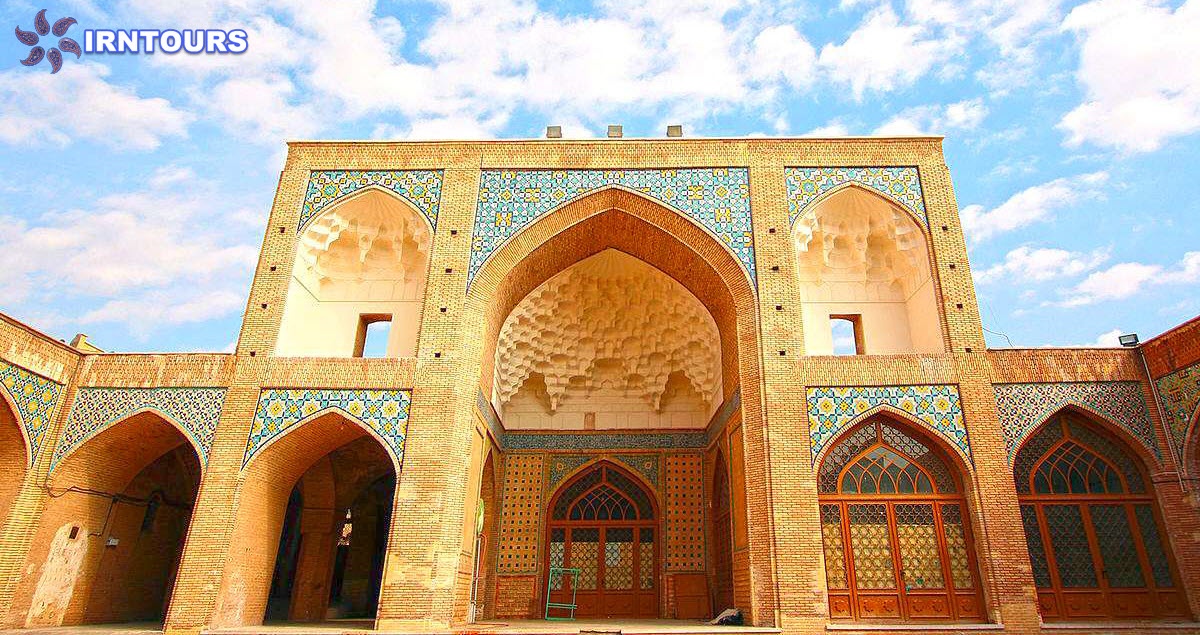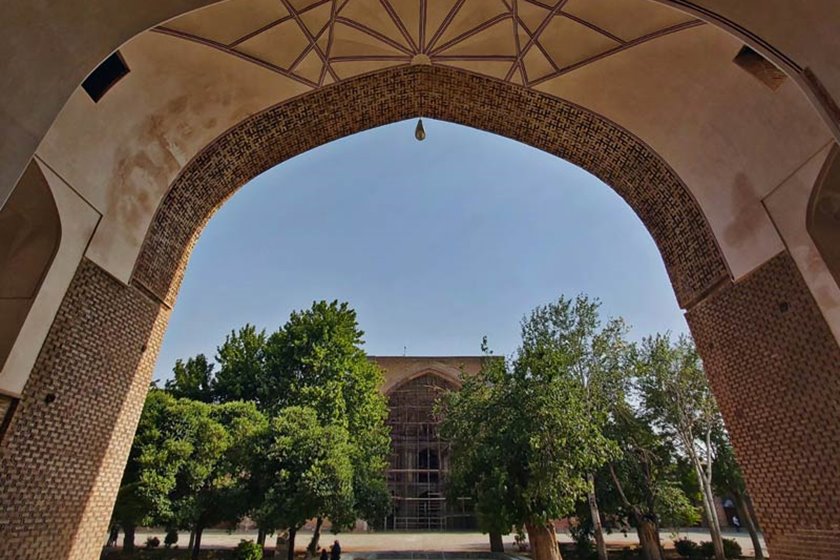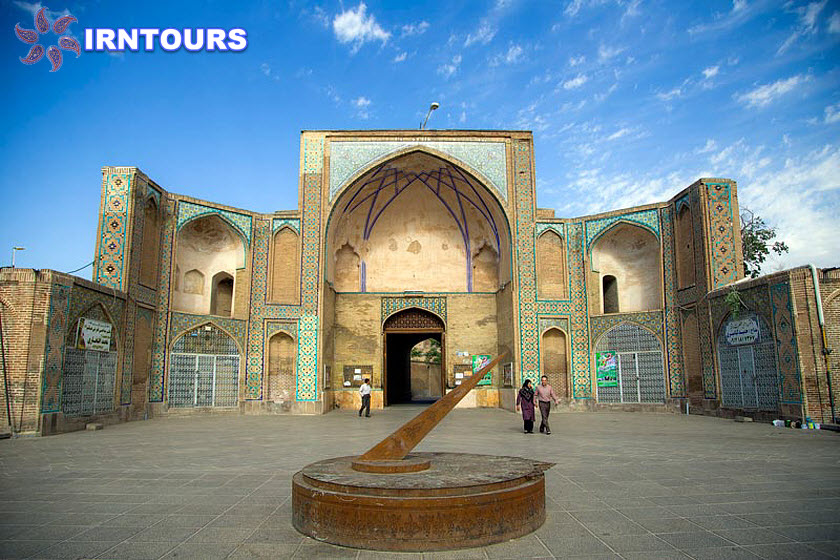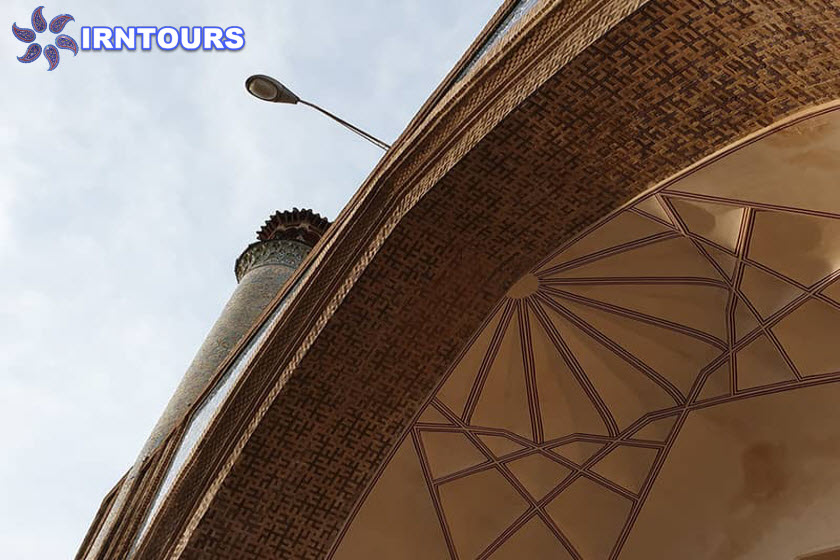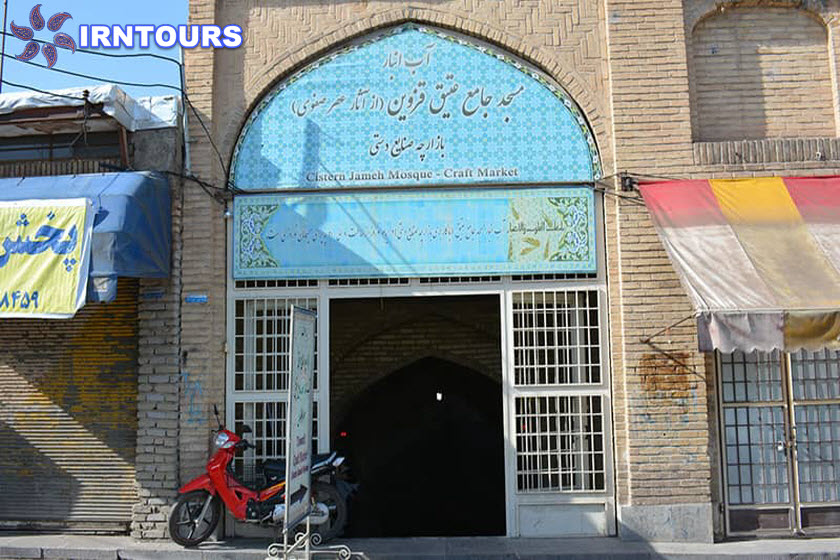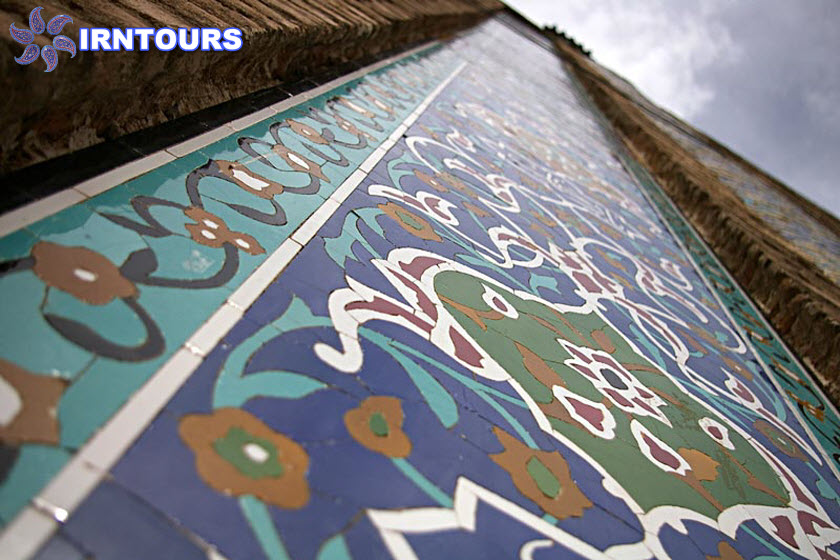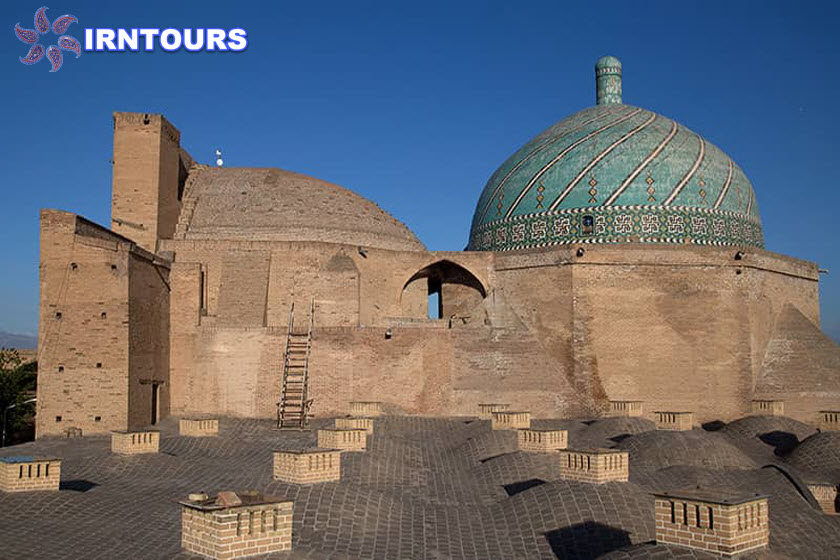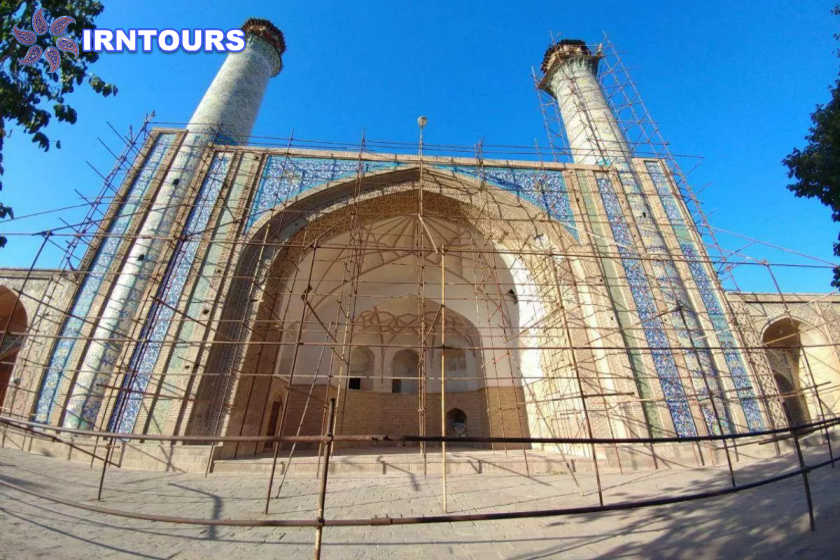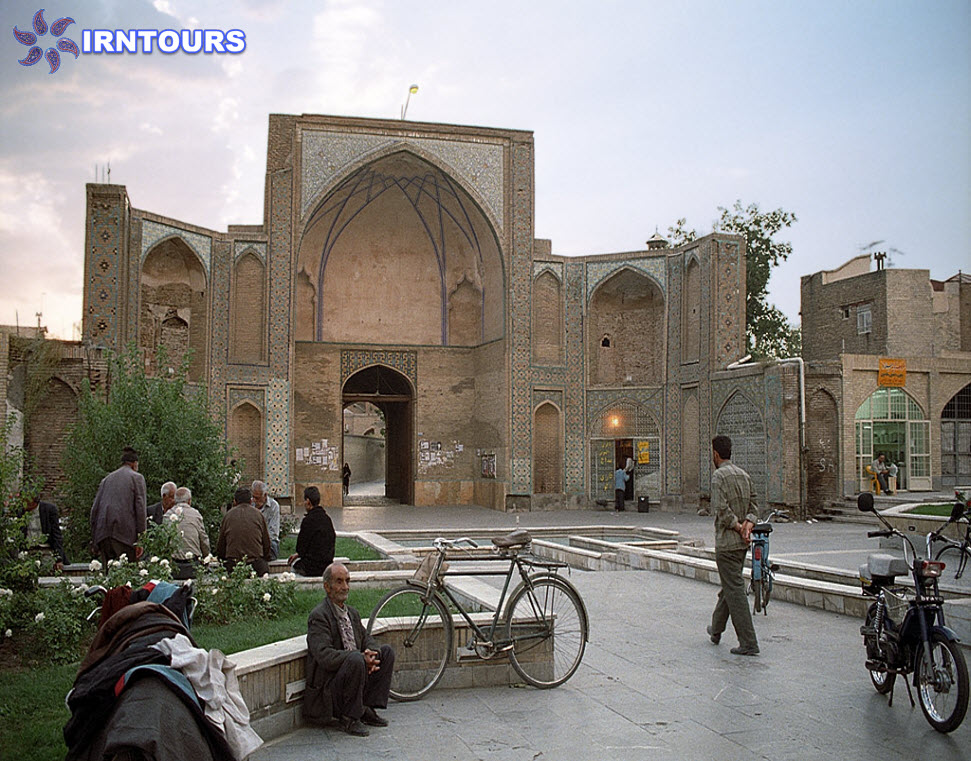
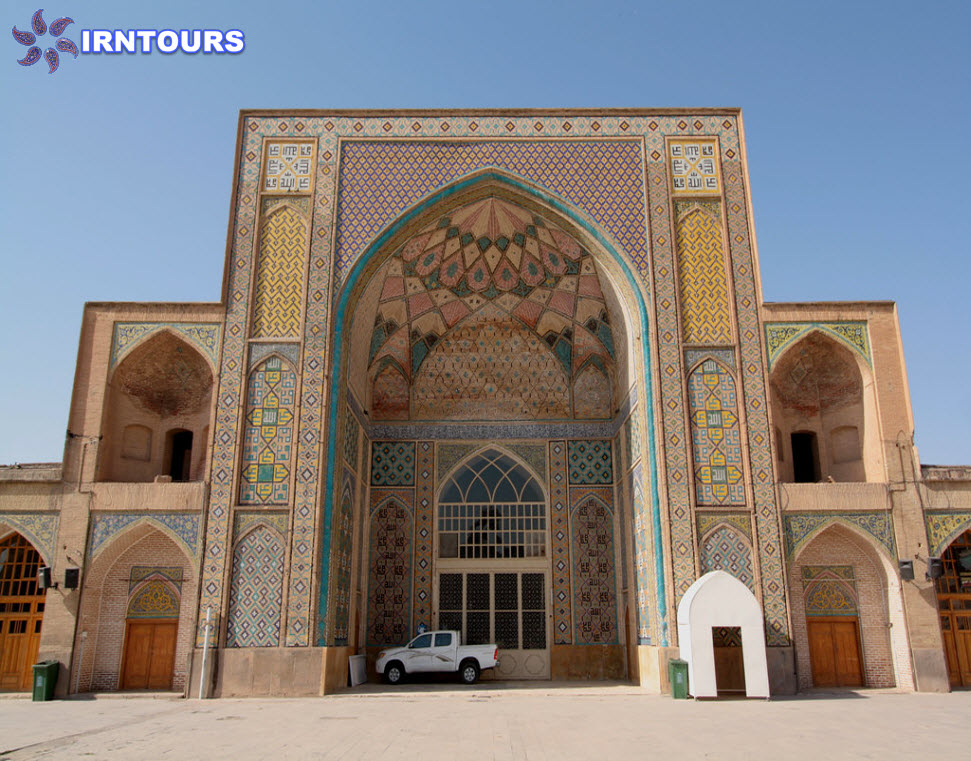
About Jameh Mosque of Qazvin
Jame Mosque of Qazvin or Jame Atiq Mosque is one of the largest and oldest mosques in Iran and one of the sights of Qazvin, which was built in 192 AH by the order of Harun al-Rashid. This mosque exhibits the architectural wonders of different eras of history and contains narratives from the Bani Abbas era to the Qajar era. The most excellent Iranian-Islamic architecture can be seen in the very beautiful dome of the mosque and its tiled minarets and courtyards. This mosque is considered among the national monuments of Iran and it is possible to visit it during congregational prayers.
Where is Jameh Mosque of Qazvin ?
To visit Qazvin Jameh Mosque, you should go from Valiasr intersection to Azadi intersection or Sabze Maidan. Then go to the left and continue your path. Passing through Prophetiye Street and the old building of Grand Qazvin Hotel, you will reach the current Sepah or Shohada Street, where the mosque is located.
The main entrance of Qazvin Grand Mosque is located on Shohada Street (Sepah Street).
- Address: Qazvin Province, Qazvin City, Shohada Street (Sepah)
History of Jameh Mosque of Qazvin
The Jame Mosque of Qazvin includes a collection of different and numerous architectural styles, from the Bani Abbas period to the Qajar kings, whose oldest architectural sign dates back to the 2nd century AH. Before it was converted into a mosque, this valuable historical building was a Sassanid fire temple, which was used as a mosque after the conversion of Qazvin residents to Islam and the large migration of Arab tribes to this city. It is said that this happened in 192 AH by the order of Harun Al-Rashid and the mosque was built on the ruins of the Sasanian fire temple. Of course, according to some narrations, Harun al-Rashid, along with the judge Abu al-Hasan Muhammad bin Yahya bin Zakaria and the owner Abi al-Abbas bin Sirih, built this mosque and gave it the title of Aaron’s Arch.
Qazvin Grand Mosque was invaded at different times of history and subsequently it was restored many times. It is interesting to know that a part of the south porch, which is the most beautiful and important porch of the mosque, was set on fire in the distant past following the invasion of the Mongols and the invasion of Afghans, and in the course of time, it was restored and revived. In addition to the south porch, the beautiful pediment of Qazvin Jame Mosque has not been spared from the damage of the times and was last restored during the Qajar period. In the year 413 AH by the order of Ibrahim Marzban Tabaqat, The floors of the great courtyard were rebuilt.
Despite the fact that the original building of the Jame Mosque dates back to before Islam; Between 500 and 509 A.H., by order of Amir Khamartash, the minister of Seljuq sultan Malik Shah, parts such as a brick dome, court, school, monastery, well, and Khamartashi’s enclosure were built on the south side of the mosque, and many changes were made on it during the Safavid period. . In the year 548 AH, King Muzaffar al-Din al-Arghun bin Tash built a small house facing the Qibla, where the assembly of interpretation and hadith was held. During the Safavid era, large sections were added to the mosque, including porches, minarets, and porticoes. Finally, during the Qajar period, during the rule of Saad al-Sultaneh, a part of the building was reconstructed and the mosque became its current form.
In May 2013, Qazvin Province Cultural Heritage, Handicrafts and Tourism Organization opened the Stone and Pottery Museum in the western part of this historic mosque. In this museum, all kinds of pottery, petroglyphs, sashes, tiles and all kinds of plasters were exposed to the eyes of those interested, and now the museum’s works have been transferred to Aali Qapo mansion. A museum called the Daricheh Museum was also operating in this place, which was dismantled.
Qazvin Grand Mosque is one of the oldest and largest Iranian mosques, which is also known as the Great Mosque and the Atiq Mosque. The Jame Mosque is one of the five largest mosques in Iran, which was built after the introduction of Islam to Iran. This historical structure is located in the first row of Iran’s four-evan mosques, and its most important and beautiful porch is the south porch. Jame Mosque was very small and even had a single porch before the Safavid era. The Seljuk dome, Harouni arch, tall minarets and eye-catching inscriptions are among the amazing attractions of this historical mosque that delight visitors. This mosque was registered in the national register in January 1932.
Different parts of Qazvin Grand Mosque
- The Dome : There is a large turquoise dome in the southern part of the mosque, which remains from the Seljuk period and is a double dome type. This dome is one of the first examples of dome construction in Iran.
- Mihrab : In the southern part of the mosque, there is a beautiful mihrab covered with marble, which is decorated with colorful tiles and plaster inscriptions. At a short distance from the altar, a beautiful stone pulpit can be seen.
- The minarets : There are two magnificent minarets on the top of Qazvin Grand Mosque, whose colorful paintings and tiles depict the art of the Qajar era.
- cellar : The cellar or basement, which is now part of the great library, had another use in the past and was a place for congregational prayers in the summer. The cellar of Qazvin Jame Mosque was built in 1313 AH by Baqer Khan Saad al-Sultaneh at the expense of Mirza Ali Asghar Khan Atabak.
- Cistern : There is a water reservoir in Jalukhan Mosque, which is known as the water reservoir of Jame Qazvin Mosque. According to the existing inscription, the construction of this building is related to the reign of Shah Suleiman Safavi and includes a large tank and thick walls that go deep into the ground with 37 steps. Currently, this reservoir is considered the oldest reservoir in Qazvin city, which was registered in the list of national monuments of Iran in 1998.
- Drinking Place : There is a watering hole in the courtyard of this mosque, which is located between the pond and the eastern porch of the building. This drinking fountain reaches the Khmartash aqueduct with 10 steps, the water of this aqueduct passes through the heart of the drinking fountain, goes to the south of the city and appears outside the gate of Imamzadeh Hossein (AS).
- Aaronic Arch : Among the southern porticoes of the mosque there are two rows, one of which is known as Taq Haruni or Gonbad Haruni; The arch that connects to the eastern entrance hall. According to historians, this arch is the oldest part of the mosque of Qazvin Mosque, which was built by order of Harun Al-Rashid. In the building of Harouni, materials such as large raw clay and clay are used.
- South porch : The most important and most beautiful porch of Qazvin Jame Mosque is its south porch, which has a two-story building. Ashkoob in architecture means floor and roof.
- North porch : The northern porch is considered to be one of the buildings belonging to the Safavid Shah Tahmasb period, which has undergone many restorations. Once upon a time, there was a large mosque between the two beautiful minarets and the tiling of this porch, which has now been dismantled.
- West porch : The western porch is located in front of the eastern porch, and on both sides of it, two northern and southern corridors were built during the time of Shah Suleiman Safavid. In the past, this porch had beautiful decorations and colorful tiling, of which there is no trace.
- Eastern porch :There is no clear information about the details of the eastern porch and its history; But Baqer Khan Saad al-Sultaneh, the governor of Qazvin at the time, ordered and at the expense of Mirza Ali Asghar Khan Atabek, rebuilt this porch in the years 1312-1313 AH, and its construction remains half-finished until today.
- Khamartashi compartment : The Khamartashi chamber or Jafari arch is located behind the south porch and is one of the remaining parts of the Seljuk period, which was built by Amir Khamartash during the reign of the Seljuk king. This square-shaped chamber has arches around it, and in its southern part, a marble altar with colorful tiles and a stone pulpit can be seen.
Inscriptions of Qazvin Grand Mosque
- The inscription above the entrance to the mosque : Currently, only a part of this historical inscription remains. “It was completed to Sarkari Ki Khosro Gholam Khase Sharifa” can be seen on the inscription.
- The inscription on one of the mosque doors : There is a Quranic inscription on this door.
- The eight-shaped inscription at the main entrance of the mosque : A quatrain is written on it
- Dome inscriptions : There are five eye-catching inscriptions in the dome, which are related to the Khamartash period. The first inscription is written on the eight sides of the dome and includes information such as the name of the maker of the dome and the time it took to build it. The second inscription contains the names of villages and farms in Kufi Jali script. The third inscription can be seen from the east of the altar to the west with a spiral Kufic script and contains the verses of Surah Baqarah. The fourth inscription covers the northern side from the east of the mihrab to Mantahaaliyah and shows a description of the endowments of Khaldashian Khamartash bin Abdullah in the third script. The fifth inscription can be seen on the eastern side of the dome, where the dedication letter and the description of the water distribution of the aqueduct of Khamartash are engraved in Kufic script.پ
- Inscriptions between the two floors in the south porch : Between the two floors of this porch, an inscription in Nastaliq script and in azure color can be seen on a lemon tile.
- The inscription above the second floor in the south porch : On this inscription, Surah Juma is written in naskh script.
- Tablets on both sides of the south porch : The plaque on the right side of the porch belongs to the era of Shah Suleiman Safavid in 1670 and the plaque on the left is assigned to Fath Ali Shah in 1823. On these two tablets, the mosque’s expenditure rules, including the salaries of muezzins, servants, etc., are engraved.
Tips for visiting Qazvin Grand Mosque :
- In May 2022, parts of the mosque were under renovation.
- Congregational prayers are still held in this mosque and it is possible to visit it only during prayer hours.
- Among the attractions near Qazvin Jame Mosque, we can mention Chehelston Palace, Sardar Mofkham’s house, Hamdollah Mostofi’s tomb and Bilour bath.

